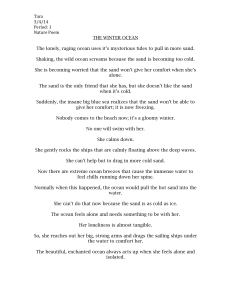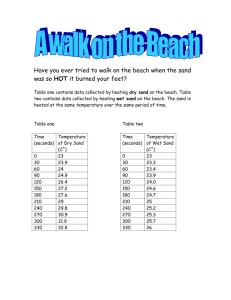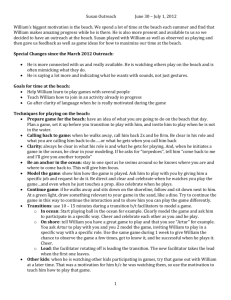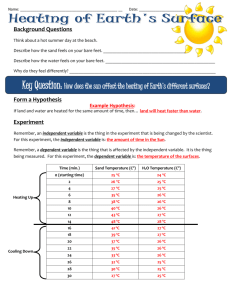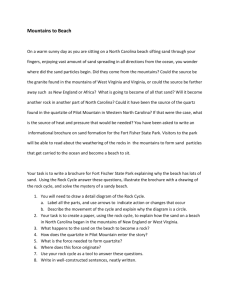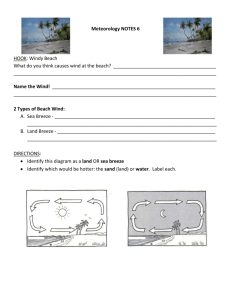How does the sun affect earth?
advertisement
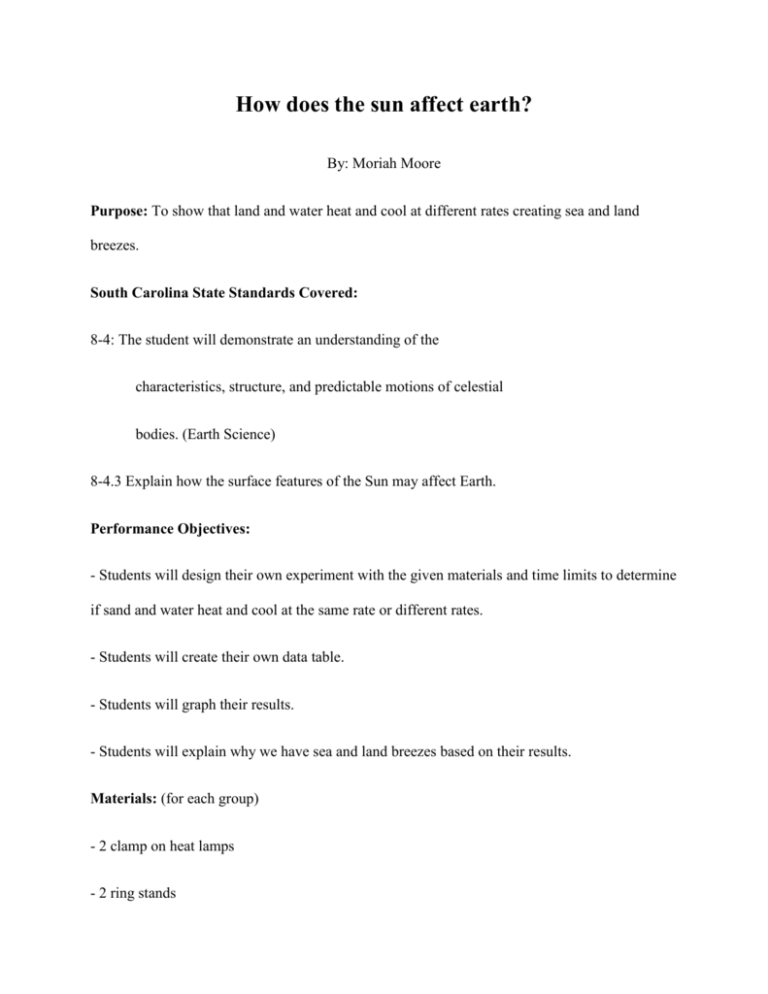
How does the sun affect earth? By: Moriah Moore Purpose: To show that land and water heat and cool at different rates creating sea and land breezes. South Carolina State Standards Covered: 8-4: The student will demonstrate an understanding of the characteristics, structure, and predictable motions of celestial bodies. (Earth Science) 8-4.3 Explain how the surface features of the Sun may affect Earth. Performance Objectives: - Students will design their own experiment with the given materials and time limits to determine if sand and water heat and cool at the same rate or different rates. - Students will create their own data table. - Students will graph their results. - Students will explain why we have sea and land breezes based on their results. Materials: (for each group) - 2 clamp on heat lamps - 2 ring stands - 2 thermometers - 2 timers or stopwatches - 2 cups - water - sand or dirt Activity: Lead a discussion through questions and answers on what the sun provides earth (heat, light, energy), what different surfaces we have on earth, and whether or not the students think the sun affects those different surfaces in different ways. Ask the students what main 2 surfaces are at the beach (sand and water, and ask if they think these two surfaces are affected differently by the sun. Have the students individually write a hypothesis of how they think the sun affects sand and water (e.g. the sand heats up more quickly than water, the water heats up more quickly than sand, or sand and water heat at equal rates from the sun). Have each group gather the above materials if they are not already on each groups table. Give the students 5 minutes to design an experiment as a group and with the given materials to test their hypothesis (not everyone in the group needs to have the same hypothesis). You may need to guide their design toward setting a time interval for taking measurements, making sure they have equal amounts of sand and water under each lamp, and making sure the lamps are the same height above the sand and water. After their 5 minute design time make sure and discuss safety such as: once the heat lamps are turned on they will be hot and they are using glass thermometers and glass bulbs and safety goggles must be worn. This is also a good time to look around the room for safety problems such as having the lamps touching the sand and water containers (you do want the lamps close to these containers though to maximize the heating process). Demonstrate that if the thermometer remains in the container, the lamp is too close to the thermometer and the thermometer may be measuring the lamp’s heat more so than the temperature of the sand or water. Also demonstrate that when they are putting the thermometer in the container to take a measurement the container should be taken from under the lamp for the same above reason. Give the students 10 minutes with their lamps on to take measurements at their chosen interval. Then turn the lamps off and continue taking measurements for another 10 minutes to see if sand and water cool at different rates. During this cooling period the students can begin graphing their results. We graphed the sand and water on the same graph for a more direct comparison of the two. After all heating and cooling measurements have been taken lead a discussion about the results. What was your hypothesis and did you support your hypothesis? Why or why not? The sand should heat and cool much more quickly than the water. Air over the sand should be warmer than air over the water during the day since the sand is warmer than the water. Where does hot air go (it rises)? Since the warm air over the sand is rising, something must take its place. What will take its place (cooler air)? From where (over the water)? This creates a sea breeze (hot air rises over hot sand and cool air blows in from cool water). At night will the sand or water cool down more quickly (sand cools more quickly). Continue questions but here is the explanation. At night the water is warmer than the sand, therefore the air over the water is rising and the cooler air from the land is blowing out over the water creating a land breeze. Either explain or continue the question and answers about the heat capacity of water, light reflection on water’s surface, and the fact that only the first few feet of the land will heat up during the day, while the heated water penetrates much deeper. Activity A 1.) List 2 things that we get from the sun: a. b. 2.) If the ocean is 65°F and the nearby beach is 65°F when the sun rises in the morning, (circle one) a. The beach will heat up faster than the ocean. b. The ocean will heat up faster than the beach. c. Both the beach and the ocean will heat up at the same rate. 3.) Other than affecting temperatures on earth, do you think the sun affects weather patterns on earth (i.e. wind, rain, droughts, hurricanes)? Temperature, °C Effects of the Sun Elapsed time ( ) Activity B 1.) If the ocean is 75°F and the nearby beach is 85°F when the sun sets in the evening, (circle one) a. The beach will cool off faster than the ocean. b. The ocean will cool off faster than the beach. c. Both the beach and the ocean will cool off at the same rate. 2.) During the day, is air above the beach or air above the ocean rising? 3.) During the day, is air moving from over the ocean toward the beach (sea breeze) or from over the beach toward the ocean (land breeze)?
